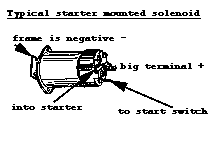CHECKING OUT A STARTER MOTOR AND SOLENOID
Starter motor problems usually are indicated by the following symptom: Turn the key to the START position and you hear a loud click, or sometimes you hear nothing. The headlights are bright and don't dim when you turn the key to START, and everything else electrical seems to work fine. It could be a bad starter neutral switch or a bad key switch but about 99% of the time it's a bad starter or starter solenoid.. Here is the procedure for checking out a starter motor and its solenoid.
Problems in a starter motor normally involve a "bad spot" on the commutator, the electrical section of the armature that contacts the brushes. They get dirty and worn down. The brushes sometimes wear out but not normally. Open circuits can occur in the armature or in stator windings. You could fix these problems but the normal procedure is to replace the starter with a rebuilt. If the starter motor armature just happens to stop on a "bad spot" the circuit is open and the starter won't turn. Sometimes you can "rock" the engine by hand (be careful - make sure the ignition switch is off) or in a standard transmission car you can put it in gear and "rock" the car by pushing it forward or backward a few inches - this can move the starter motor off the "bad spot" and get you on your way, but it's a crap shoot as to when it will happen again. Sometimes rapping the starter with a hammer can make temporary contact where the contact was flaky, but you can do more harm to the starter than good if ya hit it too hard!!
You can diagnose the starter by measuring the current draw. You can purchase a small "clamp on" ammeter that you simply lay on the cable to the starter - ya don't have to disconnect anything. Crank it and watch the little needle tell you what the current is. If there is a high current draw then you know that the starter is at fault. There is one main reason for a starter to fail when it is hot - worn bearings, especially in the tailshaft. The heat generated in the starter by the engine and the exhaust pipes (sometimes) causes the armature to expand. If the bearings are worn then the armature drags (actually contacts) on the stator causing a short circuit and a high friction drag. Sometimes just replacing the bearings can fix the problem.
When checking out a starter motor it is a good idea to remove it from the car and lock it firmly in a vice. If you don't hold it down securely, like in the jaws of a vice, and it turns out to be good, it will twist rather violently when it spins and possibly fall off the bench onto your big toe - could really ruin your weekend. You can do the following test with the starter in the car but it makes it a bit more difficult and there is a chance of shorting out the test jumper cables to ground.
Referring to the above diagram, the "big terminal" on the starter solenoid is where the battery + cable goes. There are one or two smaller terminals on the solenoid, one going to the "start" position on the ign switch.
On a bench test, the negative battery jumper cable goes to the vice that is holding the starter by the frame. The Positive goes to the "big terminal" on the solenoid. Jump from the big terminal to one of the smaller ones with a jumper wire or a screwdriver blade to actuate the solenoid. It should click and the starter should whirrrrr. If it does, don't get carried away and let it spin freely for a long time - it's not good to run a starter with no load for extended periods of time, especially an old and tired one.
If it doesn't spin, look for another "big" wire going into the starter. On GMs you can usually see it at the other end of the solenoid - it goes into the body of the starter. I'm not sure about other makes and models. Look around. Carefully touch the + jumper cable to it and the starter should immediately whirrrr and you should get a good sized spark - that is normal - the starter is a heavy current eater.
If you get no whir from that test then the starter motor is fried inside. You can take it apart and see if it is fixable (new brushes, a clean-up of the commutator and possibly new windings, but at that point I would suggest a rebuilt starter/solenoid assy.
If the starter did whir on the last test then you can remove the solenoid and either rebuild it or replace it, the later being a good idea. The new starter will come with a new or rebuilt Bendix drive which is probably next in line for failure.
When going for a new starter make sure to bring the old one along with you. First, you can match it up to make sure the computer picked the right one for your vehicle and second, they charge a "core charge" for the old one - they want it back to be rebuilt and sold again. Just to make sure you got a good one you should bench test the new starter - it wouldn't be the first time a bad rebuilt was shipped.
Back to Brother Bob's Home Page
Copyright © 1996 by Bob Hewitt - All rights reserved
